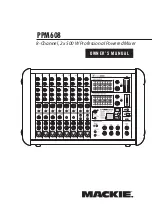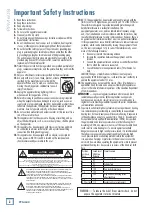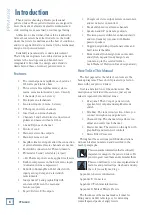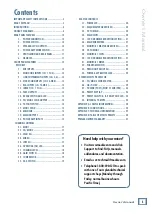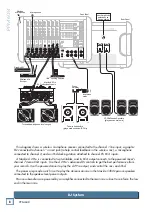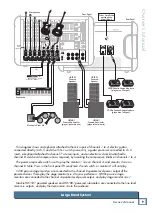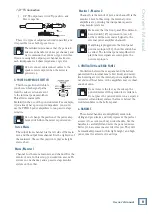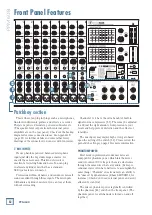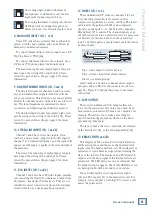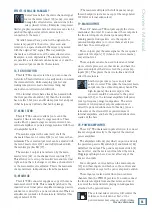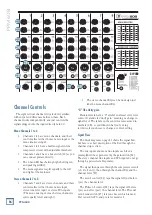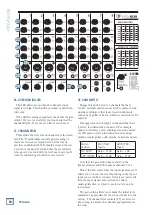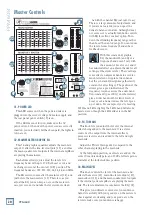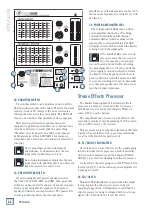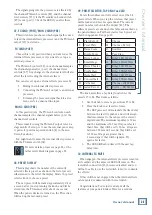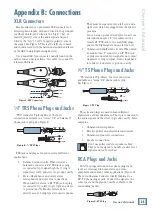
13
Owner’s Manual
Owner’
s Manual
12. INSERT (CH. 1 to 6)
These unbalanced 1/4" jacks on channels 1 to 6 are
for connecting serial effects processors such as
compressors, equalizers, de-essers, or filters. The insert
point is after the gain switch [28] and compressor
circuits (on channels 1 – 4), but before the channel’s
EQ and level [27] controls. The channel signal can go
out of the insert jack to an external device, be processed
(or whatever) and come back in on the same insert
jack. To do this requires a special insert cable that must
be wired thusly:
Tip = send (output to effects device)
Ring = return (input from effects device)
Sleeve = common ground
Insert jacks can be used as channel direct outputs;
post-gain, and pre-EQ. See the connector section on
page 26 (Figure F) showing three ways to use insert
connections.
13. TAPE OUTPUTS
These stereo unbalanced RCA outputs allow you
to record the main stereo mix onto a tape deck, hard
disk recorder, automatic CD burner, or a computer, for
example. This allows you to make a recording for
posterity/archive/legal purposes whenever the band
gets back together again.
The tape output is the stereo main mix, not affected
by the main level [34], or the main graphic EQ [32].
14. BREAK SWITCH and LED
This important “take-a-break” switch quickly mutes
all the microphones and the mono channel line-level
inputs when the band is between sets. This will prevent
protestors or rogue karaoke singers from storming the
stage at the interval. The monitor 1 and FX/monitor 2
outputs, and the drive signal to the internal effects are
also muted. The LED will come on, as a reminder that
the break switch is engaged. Check this LED first, if you
are having trouble with no sound in your system.
You can still play the stereo channel line inputs
[10] and RCA inputs [11] in the main stereo mix. For
example, you could play a soothing CD to restore order
before the police arrive.
Never plug single-ended (unbalanced)
micro phones, or ribbon mics into the mic
input jacks if phantom power is on.
Do not plug instrument outputs into the mic
XLR input jacks with phantom power on,
unless you know for certain it is safe to do so.
8. MONO LINE INPUTS (CH. 1 to 4)
These 1/4" jacks share circuitry (but not phantom
power) with the mic preamps, and can be driven by
balanced or unbalanced sources.
To connect balanced lines to these inputs, use a 1⁄4"
Tip-Ring-Sleeve (TRS) plug.
To connect unbalanced lines to these inputs, use a
1⁄4" mono (TS) phone plug or instrument cable.
The mono line inputs may employ high or low gain
based upon the setting of the switch [28]. Please
review the gain switch settings on page 18 for more
information.
9. LINE/INSTRUMENT INPUTS (CH. 5 and 6)
The line-level inputs for channels 5 and 6 can also
accept instrument-level signals if the hi-z switches
[30] are pressed in. This allows you to connect guitars
directly to channels 5 and 6, without the need for a DI
box. The input impedance is optimized for direct
connection, and high-frequency fidelity is assured.
The line/instrument inputs may employ high or low
gain based upon the setting of the switch [28]. Please
review the gain switch settings on page 18 for more
information.
10. STEREO LINE INPUTS (CH. 7 and 8)
Channel 7 and 8 have stereo line inputs. If you
just have a mono source, plug it into the left input of
channel 7 or 8 (labeled left/mono), and the signal will
appear (as if by magic) equally on the left and right of
the main mix.
The stereo line inputs may employ high or low gain
based upon the setting of the switch [28]. Please
review the gain switch settings on page 18 for more
information.
11. RCA INPUTS (CH. 7 and 8)
Channel 7 and 8 also have RCA line inputs, suitable
for connecting the line-level, unbalanced output from
CD players, tape decks, iPod docks etc. They are not
suitable for direct connection of phono-level outputs
from turntables, as a phono preamp is required.
“tip”
This plug connects to one of the
mixer’s Channel Insert jacks.
“ring”
tip
ring
sleeve
SEND to processor
RETURN from processor
(TRS plug)

